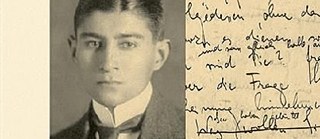German in the context of multilingual Prague
Franz Kafka’s Literary Language

For a long time, Franz Kafka’s German was only known from the posthumous edition by his literary executor Max Brod. However, in order to maximise the dissemination of his friend’s writings, Brod had intervened to correct them, especially with the intention of removing all “Prague-isms” indicative of the regional usage of the city of Prague.
By Boris Blahak
Hence, even Kurt Tucholsky and Hermann Hesse believed that Kafka’s German was “exemplary,” indeed “classic.” Ostensibly, Prague’s circles of writers seemed to confirm this, claiming for themselves “pure and genuine High German,” according to Johannes Urzidil. In contradiction to this, however, Kafka himself had noted that outside Bohemia he was conspicuous for his “Prague German.” Only the Kritische Kafka-Ausgabe, published since 1982 by S. Fischer (Frankfurt/M.) and containing all of the edits by Kafka’s hand as well as the interventions of his editors, opens up an authentic view of the German language widespread in Prague around 1900. For in the tempo, quickness, spontaneity, but above all emotion and ecstasy that characterised his writing process, Kafka was latently susceptible to errors. In the resulting layer of immediate corrections, which depict the text in its nascent state, Kafka’s verbal usage left behind clear traces.
By critically examining his writing, an error grammar of Kafka’s prose German was created, which allows a formal reconstruction of his everyday language. In order to group repetitive special forms in his autograph and assign them to a specific source (dialect, Yiddish, Czech), the methodological approaches of various linguistic sub-disciplines were linked: Fehlerlinguistik, which examines the written German of dialectal speakers with regard to the adoption of dialectal patterns, dialectology, which supports this method with grammars, dictionaries and language atlases on German vernacular regions, and contact linguistics, which researches the (collective) stable transfer of elements from one language to another. In a further step, Ulrich Ammon’s model of standard languages was used to assess whether the regionalisms thus determined in Kafka’s prose belonged to a regional (Austrian, Bohemian, Prague) standard or were excluded from the written language. For this purpose, it was checked whether they occur in contemporary reference sources (grammars, dictionaries, publishing guidelines, daily newspapers, fiction).
“Viennese-influenced east-central Bavarian urban vernacular”
For the most part (55 of 103 types) Kafka’s regionalisms are of dialectal origin. Kafka could be identified as a speaker of a Viennese-influenced east-central Bavarian urban vernacular. This is indicated primarily by phonetic features some of which are characteristic of all Upper German, some of them only for the Bavarian dialects, or even exclusively for the Viennese. They include dropping the e in the prefixes ge- and be-: as in “glüftet,” “weggangen,” “bhandeln”; the un-rounding of ö, ü and eu: “meglich” (möglich), “Thier” (Tür), “trei” (treu); mixing b/p-, g/k- and d/t: “Bult” (Pult), “glein” (klein), “Schulder” (Schulter); dropping (the vocalisation) of the l after a vowel: “sebst” (selbst), “Wöbung” (Wölbung), “fühten” (fühlten); and the monophthongization of ei to ä [ɛ:]: “Brete” (Breite), “Gereztheit” (Gereiztheit), “Feenheit” (Feinheit). In its morphology, Kafka’s German also exhibits numerous dialectisms. The personal pronouns “i” (ich) and “mir” (wir), the article forms “a” (ein, eine), “dee” (die) and “dees” (das) as well as verb forms such as “rucken” (rücken), “ziegen” (ziehen) and “gekennt” (gekannt) vividly reveal the contours of Kafka’s primary language. Kafka, who in his youth ascribed himself a German with an “Austrian tinge,” was apparently truly an “Austrophone.”Linguistic attributes of Yiddish and Czech
In addition, there are traces of Yiddish in Kafka’s German: 26 percent of all evidences of regionalism in the articulation can be assigned to the former language of Prague’s Jews. These include above all the striking spellings using z instead of s and f instead of w at the beginning of the word. Hence, Kafka may well have said “Zache” (Sache), “zondern” (sondern) and “Zessel” (Sessel), “Färme” (Wärme), “fissen” (wissen) and “fickelte” (wickelte); he would have dropped the p in pf and said f at the beginning of a word, and as p in the middle: “Fosten” (Pfosten), “Ferd” (Pferd) and “kramphaft” (krampfhaft). In his morphology, we encounter conspicuous dative forms of the interrogative pronoun wer: “um wem es sich handelt,” “Wem suchst Du?” Also Kafka’s one-sided use of her- in composite directional adverbs follows the Yiddish pattern: “Jetzt wäre ich bald herausgefallen” (Yiddish aroys, German heraus/hinaus). In this respect, Kafka was not practicing literary self-stylisation when he attested that he spoke a “German that we still have in our ears from our un-German mothers.” These Yiddisms are among the remnants that were apparently still alive in Prague’s German-Jewish circles around 1900 and were adopted by Kafka as a child with the German of his socialisation milieu. As part of an ethnolect, they document the final stage of the language change of Bohemian Jews in the nineteenth century and give Kafka’s “Austrophony” a “western Yiddish accent.”Finally, Czech speech patterns are found mainly in the syntax. Repeatedly, word classes are absent that don’t exist in Czech, for one articles: “bei Tür,” “durch Labyrint,” “auf Ofenbank”; for another the conjunction zu: “ob es richtig war, so handeln,” “sie suchten einander zurückdrängen,” “er scheint ihn gar nicht gelesen haben.” Such linguistically contrastive norm violations are as typical in Czech German speakers as Kafka’s variations between the prepositions an and auf, which coexist in the Czech equivalent na: “an/auf der Decke hängen,” “an/auf die Türe schlagen,” “etwas an/auf etwas hängen.” These verifications of German-Czech language contact must also have been integrated into everyday life in Prague when Kafka was socialised in his native language; in some cases, they even turn out to be regionally standard as they can also be found in the Prague daily press or fiction. Thus, it could also be proved that there was a specific standard of German in Prague that occasionally deviated from the official Austrian writing standard.